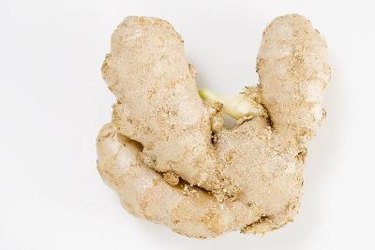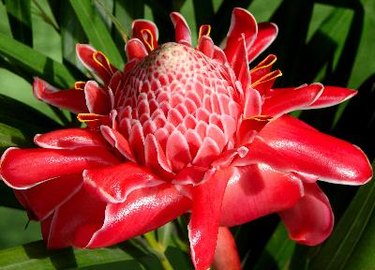
Numerous species of tropical herbs are commonly called gingers. While the ginger spice plant belongs to the botanical genus Zingiber, other gingers belong to the genus Alpinia, Globba, Costus, Etlingera or Hedychium. Regardless of precise identity, gingers bloom when temperatures are warm and soil moisture and ambient humidity are high. Depending on climate, gingers flower anytime from spring to fall based on the genetics within each species.
Types
Video of the Day

From a gardener's perspective, only a handful of gingers are grown or commonly encountered. Shell ginger (Alpinia zerumbet), Thai ginger (Alpinia galanga) and red ginger (Alpinia purpurata) are closely related. Gardeners prize the torch ginger (Etlingera elatior) as a cut flower. Butterfly gingers or ginger lilies include the species Hedychium coccineum, H. coronarium, H. gardnerianum and H. flavescens. Beehive ginger (Zingiber spectabile), bitter ginger (Z. zerumbet) are close cousins to the spice ginger (Z. officinale). However, the spice ginger plants rarely flower because they've been cultivated for centuries and selected for their roots, not for producing flowers.
Video of the Day
Time Frame
Across their native tropical habitats, the various species of gingers often go dormant or cease growth during the tropical dry season, or winter. Leafy stems emerge once again from the underground rhizomes in spring when warmth and rains return. Flowering ensues anytime during the tropical rainy season, which extends for varying lengths from spring to fall. For general perspective, assume that ginger plants concentrate blooming across the summer months.
Features of Ginger Flowers

Gingers in the genus Hedychium produce showy flowers that are tubular in shape with large lobes. Shell ginger flowers look like glossy urns. However, other ginger flowers are tiny and fleeting but born from large waxy clusters of colorful bracts. The flower may last only a couple days, but the bracts are long lasting and often look more ornamental and colloquially considered the flower worth cutting and putting in a bouquet. The leafy plant stems often hide the flowers. The bracts on the red ginger, torch ginger, and beehive ginger comprise the flower heads admired in flower arrangements.
Hardiness
Gingers grow best in tropical regions or large glass conservatories where temperatures never reach freezing. However, some species do overwinter well in USDA Plant Hardiness Zones 7b through 9 where moderate freezes and frosts occur, as their roots are dormant and insulated by the warm soil. Gingers grow once soil temperatures warm, thus, their flowering is delayed slightly depending on the progression of heat into summer.